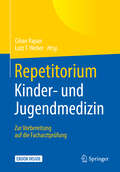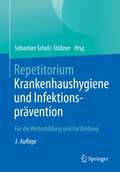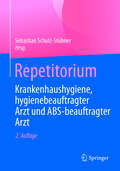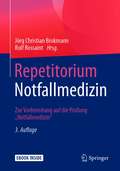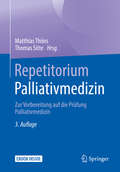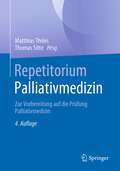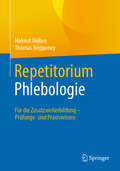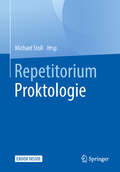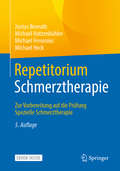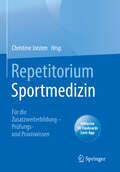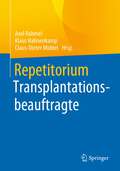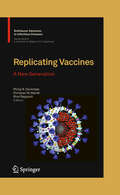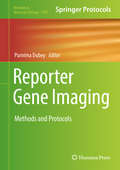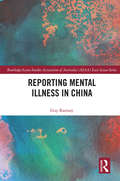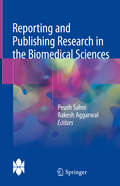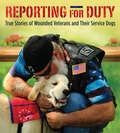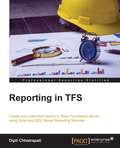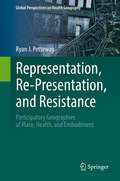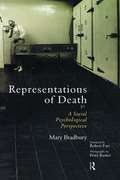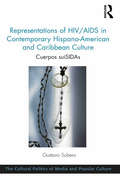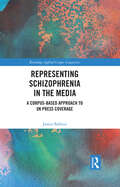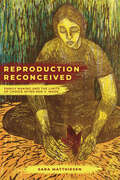- Table View
- List View
Repetitorium Kinder- und Jugendmedizin: Zur Vorbereitung auf die Facharztprüfung
by Cihan Papan Lutz T. WeberDas ideale Werk zur Prüfungsvorbereitung - orientiert am Weiterbildungscurriculum Kinder- und Jugendmedizin: Praxisnah und auf den Punkt gebracht, wiederholt das Buch für alle Assistenten, aber auch für Pädiater in den ersten Berufsjahren, auf knappem Raum die wesentlichen Fakten rund um die Versorgung von Kindern - vom Neugeborenen bis zum Jugendlichen. Tipps zu juristischen Aspekten der Tätigkeit des Pädiaters runden das Buch ab.Als Begleiter und Leitfaden während der Weiterbildungszeit gut geeignet, verfolgt das Repetitorium den Anspruch, jeder Unterdisziplin der Pädiatrie gerecht zu werden.
Repetitorium Krankenhaushygiene und Infektionsprävention: Für die Weiterbildung und Fortbildung
by Sebastian Schulz-StübnerIn diesem Buch finden Sie für Ihre Fort- und Weiterbildung rund um die Themen Hygiene und Infektionsprävention das geforderte Fachwissen. Ausgewiesene Experten für Hygiene, Infektiologie und Umweltmedizin fassen für die tägliche Arbeit bedeutsame Aspekte aus den Inhalten zur Weiterbildung „Krankenhaushygiene“ und den Fortbildungskursen „Hygienebeauftragter Arzt“ und „ABS-beauftragter Arzt“ übersichtlich, praxisnah und umsetzbar zusammen. Fallbeispiele, Praxistipps und Merksätze erleichtern die Übersicht, Tabellen fassen komplexe Sachverhalte in Nachschlageform zusammen.Für alle Mitglieder des Hygieneteams (Ärzt*innen, Hygienebeauftragte, Pflegekräfte) und interessierten Mitarbeitenden im Gesundheitswesen. Auch für Hygienefachkräfte in der Weiterbildung ideal zum Nachschlagen und Lernen.
Repetitorium Krankenhaushygiene und hygienebeauftragter Arzt
by Sebastian Schulz-Stübner17 Millionen Menschen werden jährlich in deutschen Krankenhäusern behandelt, 400.00-600.000 davon erleiden noskomiale Infektionen und ca. 10.000 dadurch bedingte Todesfälle. Insofern sind alle Träger von Krankenhäusern und Tageskliniken verpflichet, eine ausreichende Infektionsprävention und Hygienemaßnahmen zu gewährleisten. Für die praktische Umetzung sind sowohl der Ekrankenhaushygieniker" als auch der "hygienebeauftragte Ärzt/Ärztin" verantwortlich. Für diese Weiterbildungen finden Sie alles notwendige Wissen rund um die Krankenhaushygiene und Infektionsprävention: · Rechtliche Grundlagen und relevante Gesetzgebung · Grundlagen der mikrobiologischen Diagnostik und Infektiologie · Allgemeine und spezielle Hygienemaßnahmen · Wundmanagement · Infektionsprävention, u.v.m Die Texte ausgewiesener Experten auf ihren Gebieten haben in übersichtlicher Form und prägnanter Sprache Fakten, Zahlen und Maßnahmen zusammengetragen. Die Inhalte decken sowohl die Fortbildung zum"Hygienebeauftraten Arzt / Ärztin" als auch die curriculäre Fortbildung Krankenhaushygiene ab. So fällt die Wissensüberprüfung und das Nachschlagen in der Praxis leicht!
Repetitorium Krankenhaushygiene, hygienebeauftragter Arzt und ABS-beauftragter Arzt
by Sebastian Schulz-StübnerIn diesem Buch finden Sie für Ihre Fort- und Weiterbildung rund um das Thema Hygiene und Infektionsprävention das geforderte Fachwissen. Ausgewiesene Experten für Hygiene, Infektiologie und Umweltmedizin fassen in Anlehnung an die Curricula die Inhalte zur Weiterbildung „Krankenhaushygiene“ und den Fortbildungskursen „Hygienebeauftragter Arzt“ und „ABS-beauftragter Arzt“ übersichtlich, praxisnah und umsetzbar zusammen. Die 2. Auflage wurde komplett aktualisiert und um den Themenkomplex „Antibiotika Stewardship“ und „ABS-beauftragter Arzt“ erweitert. Auch für Hygienefachkräfte in der Weiterbildung ideal zum Nachschlagen, Lernen und Wissenserweiterung.
Repetitorium Notfallmedizin: Zur Vorbereitung auf die Prüfung "Notfallmedizin"
by Rolf Rossaint Jörg Christian BrokmannDas Werk liefert die wesentlichen Fakten zum Thema übersichtlich und praxisnah dargestellt. Die Inhalte orientieren sich an der Zusatz-Weiterbildung "Notfallmedizin" und an den aktuellen Leitlinien notfallmedizinischer Fachgesellschaften. Das Buch eignet sich sowohl zur Prüfungsvorbereitung der Zusatzbezeichnung als auch zum schnellen Nachschlagen rund um den Notfalleinsatz. Die 3. Auflage erscheint komplett aktualisiert und erweitert, u.a. zu den Themen Telenotarzt, nichtinvasive Beatmung, taktische Medizin, präklinische Beatmung, Analgosedierung und Narkose im Rettungsdienst. Besonderes Praxis-Plus: eBook inside – kostenloser Download des eBooks inklusive
Repetitorium Palliativmedizin: Zur Vorbereitung auf die Prüfung Palliativmedizin
by Thomas Sitte Matthias ThönsDas vorliegende Buch orientiert sich an den Inhalten der Zusatz-Weiterbildung Palliativmedizin und wendet sich an Ärzte in Weiterbildung zum Palliativmediziner, ebenso wie an alle palliativmedizinisch tätigen Ärzte. Ein Herausgeber- und Autorenteam aus der Praxis der ambulanten und stationären Palliativversorgung vermittelt prägnant, praxisnah und anhand von zahlreichen Fallbeispielen die wesentlichen Aspekte für die Begleitung Sterbender. Die 3. Auflage erscheint komplett überarbeitet und berücksichtigt die S3 Leitlinie Palliativmedizin 2019 sowie die aktuellen Empfehlungen der WHO zur Tumorschmerztherapie. Neue Themen sind u.a.: Übertherapie am Lebensende, die Rechtsprechung von Bundesgerichtshof und Europäischem Gerichtshof für Menschenrechte bis 2019 und die Diskussion um Methadon.
Repetitorium Palliativmedizin: Zur Vorbereitung auf die Prüfung Palliativmedizin
by Thomas Sitte Matthias ThönsDas vorliegende Buch orientiert sich an den Weiterbildungsinhalten der BÄK für die Zusatz-Weiterbildung Palliativmedizin. Es wendet sich an alle Ärztinnen und Ärzte, die diese Zusatzbezeichnung anstreben, ebenso wie an alle palliativmedizinisch tätigen Ärztinnen und Ärzte. Es ist aber auch für palliativ interessierte Menschen anderer Berufsgruppen zur Vertiefung geeignet. Ein Herausgeber- und Autorenteam aus der Praxis der ambulanten und stationären Palliativversorgung vermittelt prägnant, praxisnah und anhand von zahlreichen Fallbeispielen die wesentlichen Aspekte für die Begleitung Sterbender. Dargestellt werden u. a. Besonderheiten der angemessenen Begleitung Versorgung bei onkologischen und nicht onkologischen Erkrankungen, Symptomkontrolle, psychosoziale und spirituelle Aspekte sowie ethische und rechtliche Fragestellungen. Die 4. Auflage erscheint komplett überarbeitet und aktualisiert, wobei die Rechtslage dem Stand vom November 2022 entspricht.
Repetitorium Phlebologie: Für die Zusatzweiterbildung – Prüfungs- und Praxiswissen
by Helmut Nüllen Thomas NoppeneyKompakt und präzise fasst das "Repetitorium Phlebologie" die Inhalte für die Weiterbildung zur interdisziplinären Zusatzbezeichnung Phlebologie zusammen. Die Darstellung eignet sich ideal für die Prüfungsvorbereitung und zum Nachschlagen auch spezieller Fakten. Sie umfasst die anatomischen und physiologischen Grundlagen ebenso wie die gängigen Klassifikationen und Scores und die diagnostischen Verfahren. Die einzelnen Erkrankungen des Venensystems sind detailliert beschrieben, auch selten vorkommende Krankheitsformen und Syndrome finden dabei Platz. Ausführlich gehen die Autoren auf den Stellenwert der konservativen und operativen Therapieverfahren ein. In einem eigenen Kapitel sind auch die Erkrankungen des Lymphgefäßsystems berücksichtigt. Das dargestellte komprimierte Faktenwissen lässt kaum eine Frage zu dem Fachgebiet offen.
Repetitorium Proktologie
by Michael StollIn knapper und präziser, einheitlich strukturierter Form sind die Grundlagen der proktologischen Diagnostik und Therapie und die einzelnen Erkrankungen des Anorektalbereichs beschrieben. Basierend auf den Vorgehensweisen und Erfahrungen einer renommierten Spezialpraxis werden diagnostisches Vorgehen und Therapieindikationen ausführlich und mit vielen Tipps zur praktischen Umsetzung dargestellt; zahlreiche farbige Abbildungen illustrieren die typischen Befunde. Im Text hervorgehobene Schlüsselsätze und Kapitelzusammenfassungen erleichtern die schnelle Orientierung. Alle Inhalte der Zusatzweiterbildung Proktologie sind berücksichtigt; für die Vorbereitung der Prüfung ist das Buch ebenso geeignet wie als kompaktes Nachschlagewerk für alle proktologisch tätigen Ärzte.
Repetitorium Schmerztherapie: Zur Vorbereitung auf die Prüfung Spezielle Schmerztherapie
by Justus Benrath Michael Hatzenbühler Michael Fresenius Michael HeckDas vorliegende Werk vermittelt in knapper und verständlicher Form, ergänzt durch viele Tabellen und Schemata, die Grundlagen und Besonderheiten der speziellen Schmerztherapie – unter Berücksichtigung der aktuell gültigen Leitlinien für Diagnose und Therapie von Schmerzerkrankungen. Die Inhalte orientieren sich an den Weiterbildungsinhalten der BÄK für die Zusatz-Weiterbildung „Spezielle Schmerztherapie“. Das Buch eignet sich hervorragend zur Prüfungsvorbereitung, da es die wesentlichen Inhalte auf den Punkt bringt. Aufgrund der vielen Hinweise zu Indikationen, Pharmakokinetik und Wirkmechanismen sowie der zahlreichen konkreten Praxistipps und ist es darüber hinaus ein wertvoller Begleiter im Klinikalltag aller schmerztherapeutisch tätigen Ärzte. Die 5. Auflage erscheint komplett überarbeitet, aktualisiert und erweitert. Neue Themen: Psychologische und psychotherapeutische Verfahren der Schmerztherapie, suchtmedizinische Aspekte und erweiterte Darstellung der nicht-invasiven Schmerztherapie.
Repetitorium Sportmedizin: Für die Zusatzweiterbildung – Prüfungs- und Praxiswissen
by Christine JoistenDas Buch vermittelt in knapper und verständlicher Form die Grundlagen und Besonderheiten des Querschnittsfaches Sportmedizin. Die Inhalte orientieren sich an dem aktualisierten (Muster)-Kursbuch der BÄK für die Zusatzweiterbildung „Sportmedizin“, wobei neben der Energiebereitstellung, Trainings- und Leistungsdiagnostik, die spezifischen sportmedizinischen Aspekte in der Prävention und Therapie von einigen chronischen Erkrankungen vorgestellt werden. Zusätzliche wurden aktuelle Themenfelder, wie Sporttauglichkeitsuntersuchungen, Sportunfälle sowie Ernährung, Doping und ethische Aspekte von den Autoren aus Sportmedizin und Sportwissenschaft zusammengestellt. Mit Hilfe der Springer Nature Flashcards, ein digitales Fragen-und-Antworten-Tool, kann das Wissen vertieft werden. Das Buch eignet sich hervorragend zur Prüfungsvorbereitung, ist aber auch aufgrund der vielen praktischen Hinweise ein wertvoller Begleiter für alle sportmedizinisch tätigen Ärzte.
Repetitorium Transplantationsbeauftragte
by Klaus Hahnenkamp Axel Rahmel Claus-Dieter MiddelKompakt und übersichtlich fasst das Buch die Wissensinhalte zusammen, die Ärzte und Pflegefachpersonal als Transplantationsbeauftragte auf einer Intensivstation benötigen. Es kann als anschauliche Einführung in das Aufgabenfeld ebenso verwendet werden wie als Nachschlagewerk für den erfahrenen Transplantationsbeauftragten. Alle Inhalte des Curriculums der Bundesärztekammer sind berücksichtigt, damit eignet es sich auch als Begleitbuch für die curricularen Kurse. Der inhaltliche Schwerpunkt liegt auf den Fragestellungen, die für die praktische Tätigkeit als Transplantationsbeauftragter besonders wichtig sind, wie die Voraussetzungen für eine Organspende und ihre Durchführung. Doch auch organisatorische, rechtliche und ethische Fragestellungen kommen nicht zu kurz. Die Links zu wichtigen Adressen und Arbeitsmaterialien können über integrierte QR-Codes direkt aufgerufen werden.
Replicating Vaccines
by Philip R. Dormitzer Christian W. Mandl Rino RappuoliTechnological advances, together with a better understanding of the molecular biology of infectious microorganisms, are creating exciting possibilities for a new generation of replicating vaccines. Historically, live vaccines have been either directly derived from a natural source or attenuated by empirical approaches using serial passages and host cell adaptation. Currently, we are witnessing a quantum leap in our technological capabilities to specifically modify the genetic make-up of viruses and bacteria, making it possible to generate improved live vaccines and to develop completely new types of replicating vaccines, such as vectored vaccines, single-round infectious vaccines and replicon vaccines. This book highlights some of the most exciting recent developments towards a new generation of replicating vaccines.
Report to the Commissioner of Baseball of an Independent Investigation Into the Illegal Use of Steroids and Other Performance Enhancing Substances by Players in Major League Baseball
by George J. MitchellReport on rampant steroid use in major league baseball
Reporter Gene Imaging: Methods and Protocols (Methods in Molecular Biology #1790)
by Purnima DubeyThis volume provides an introduction for the scientist who is new to the field of molecular imaging, as well as detailed methods for experts in other areas of molecular imaging. Chapters detail the advantages and limitations of combining fluorescent, bioluminescent and radioisotopic, creating dual modality imaging reporter gene construct, bioluminescent imaging, and bioluminescent or fluorescent imaging. Written in the highly successful Methods in Molecular Biology series format, chapters include introductions to their respective topics, lists of the necessary materials and reagents, step-by-step, readily reproducible laboratory protocols, and tips on troubleshooting and avoiding known pitfalls. Authoritative and practical, Reporter Gene Imaging : Methods and Protocols aims to ensure successful results in the further study of this vital field.
Reporting Mental Illness in China (Routledge/Asian Studies Association of Australia (ASAA) East Asian Series)
by Guy RamsayThis book examines how Chinese-language newspapers across greater China report on severe mental illness, and why they do so in the ways they do, given that reporting in local newspapers can strongly influence how Chinese readers view the illness. By assessing how the reporting in three leading broadsheet newspapers from mainland China, Hong Kong, and Taiwan constructs the illness, the book considers how the distinct social and political histories of the three culturally Chinese communities shape the reporting, and whether it bears out or contests the intense stigma against the illness that prevails locally. The findings can usefully encourage and inform attempts to humanise, include, and empower those with a severe mental illness across greater China and the global Chinese diaspora. Employing a well-tested, transparent discourse analytic approach, the book also includes numerous Chinese-English bilingual news report extracts to illustrate its claims. As such, Reporting Mental Illness in China will be of interest to sinologists, discourse analysts, mental health professionals and public health authorities across the globe, especially in places where there are large Chinese-speaking populations.
Reporting and Publishing Research in the Biomedical Sciences: Revised Edition
by Peush Sahni Rakesh AggarwalThis book eases the task of converting research work into a manuscript, and covers the recent developments in publishing that often stump budding researchers.Few researchers in the biomedical sciences are trained in the essential skills of reporting their results, and they seek help in writing a paper that will be acceptable for publication in the ‘right’ journal, and in presenting their results ‘effectively’ at a meeting. As well as covering the basic aspects of preparing manuscripts for publication, the book discusses best practices and issues relating to the publication of biomedical research, including topics such as peer-review, authorship, plagiarism, conflicts of interest, publication misconduct, electronic publishing and open-access journals. With more than two decades of experience in conducting workshops on writing scientific papers, the editors have brought together the expertise of 29 authors from seven countries to produce this one-stop guide to publishing research in biomedical sciences. This book is intended for young researchers who are beginning their careers and wish to hone their skills and understand the rigors of research writing and publishing.
Reporting for Duty: True Stories of Wounded Veterans and Their Service Dogs
by Tracy J. LibbyInspirational accounts of veterans who have moved forward from mental and physical injuries toward healthier lives with the help of service dogs. Hundreds of thousands of military veterans seek treatment for post-traumatic stress disorder (PTSD) each year. Service dogs have been used for many years in the civilian sector to help their disabled owners perform necessary tasks in daily life; likewise, the organized use of therapy dogs to bring comfort and companionship to hospital and nursing-home patients dates back more than four decades. Reporting for Duty explores the unique and special bond between wounded warriors—especially those suffering from PTSD—and their service dogs and discusses the vital work of therapy dogs who visit VA hospitals and military rehabilitation facilities. Author Tracy Libby tells the true stories of disabled veterans who have been touched, assisted, and enriched by the dogs in their lives, and the new lease on life is reciprocal: many of these service and therapy dogs have been rescued from shelters and specially trained for their jobs. A portion of proceeds from the sale of this book will benefit a veterans&’ service-dog organization.Inside Reporting for Duty . . .True stories of physically and mentally disabled veterans who count on service dogs for assistance with daily tasksAn explanation of PTSD and how it affects military veteransHow therapy dogs and service dogs are selected and trained for their jobsRescuing shelter dogs to train for therapy and service workHow the military is training dogs to accompany soldiers on deploymentsA look at the bond between people and dogs and the positive effects it has on both
Reporting in TFS
by Dipti ChhatrapatiThis book is intended for developers, testers, architects, and project managers who want to explore and make use of the reporting facilities of Team Foundation Server 2013. Although no previous experience of reporting is required, a basic understanding of the Team Foundation Components and project templates would be a plus.
Representation, Re-Presentation, and Resistance: Participatory Geographies of Place, Health, and Embodiment (Global Perspectives on Health Geography)
by Ryan J. PettewayThis book draws on the author's ten years of participatory work to examine core themes of (mis)representation, re-presentation, and resistance within place-health research and practice. The book includes practice- and research-based projects with implications and applications for practitioners (e.g. local health department epidemiologists) and academics, introducing readers to an array of new and mixed-methods within place-health research. It also introduces new conceptual and analytical place-health frameworks that more explicitly account for power—both within place making, unmaking, and remaking processes, and within the (re)production of place-health knowledges. Across six chapters, the author reports and reflects on a selection of research projects, raising key considerations in regard to place-health (mis)representation, and highlighting the value of participatory methods and processes in re-presenting—and decolonizing—spatial narratives of health. This includes an emphasis on the integration of community-based participatory research (CBPR) principles with the technological and procedural affordances of information and communication technologies (ICTs). With each chapter drawing from CBPR, decolonizing, social epidemiology, health geography, Black feminist, and critical theory orientations, the book offers an integrated call and framing for a critical examination of how geographies of “place” and health—and narratives/stories therein—are constructed, and perhaps might be de/re-constructed through inclusive and equitable research practices that center community and offer a mode of resistance for the production of place-health counternarratives. The book is intended for academic researchers and practitioners in public health and health geography fields, particularly those whose work engages social epidemiology, urban planning, and aspects of community development, and will also appeal to researchers and practitioners who use participatory, community-inclusive methods and processes in their work, especially as related to community mapping.
Representations of Death: A Social Psychological Perspective
by Mary BradburyDrawing upon a rare and highly original ethnography of contemporary mortuary practices, Representations of Death takes the reader through the medical, bureaucratic, commercial and ritual aspects of death Going behind the scenes at hospitals, funeral parlours, crematoria and cemeteries, as well as holding poignant, in-depth interviews with bereaved women, Bradbury has been able to illuminate the very different perspectives of the deathwork professional and the grieving relative. Illustrated with stunning photographs, this fascinating book makes a significant contribution to the growing literature in death studies.
Representations of HIV/AIDS in Contemporary Hispano-American and Caribbean Culture: Cuerpos suiSIDAs (The\cultural Politics Of Media And Popular Culture Ser.)
by Gustavo SuberoExploring the mechanisms and strategies used in different cultures across Hispano-America and the Caribbean to narrativise, represent and understand HIV/AIDS as a social and human phenomenon, this book examines a wide range of cultural, artistic and media texts, as well as issues of human phenomenology, to understand the ways in which HIV positive individuals make sense of their own lives, and of the ways in which the rest of society sees them. Drawing on a variety of cultural texts from cinema, television, photography and literature, the author considers the manner in which contemporary cultural forms have shaped a body of public opinion in response to the social and cultural impact of HIV/AIDS, re-interpreting the condition in the light of advances in treatment. With attention to both the temporality and spatiality of production, this book examines whether heterosexual and homosexual, and masculine and feminine bodies are narrativised in the same manner, considering the question of whether representations foster discrimination of any kind. The book also asks whether representations across Latin America are homogenous or varied according to national, social or cultural context, and explores the commonalities between the representations of HIV/AIDS in Hispano-America and the Caribbean and other global narratives. A detailed study of the various representations of HIV/AIDS and the construction of public opinion, this book will appeal to scholars of cultural, media and film studies, the sociology of health, the body and illness, and Latin American and Caribbean Studies.
Representing Schizophrenia in the Media: A Corpus-Based Approach to UK Press Coverage (Routledge Applied Corpus Linguistics)
by James BalfourThis book presents a critical analysis of ways in which schizophrenia and people with schizophrenia are represented in the press. Interrogating a 15-million-word corpus of news articles published by nine UK national newspapers over a 15-year period, the author draws on techniques from corpus linguistics and critical discourse analysis to identify the most frequent and salient linguistic features used by journalists to influence and reflect broader public attitudes towards people with schizophrenia. In doing so this book: Evaluates the extent to which media representations are accurate and the extent to which they are potentially helpful or harmful towards people living with schizophrenia; Employs a bottom-up approach guided by linguistic patterns, such as collocates and keywords, identified by corpus software; Contributes to the de-stigmatisation of schizophrenic disorder by unveiling some of the widespread misconceptions surrounding it; Applies a mixed-methods approach in order to expose attitudes and beliefs found ‘between the lines’ – values and assumptions which are often implicit in the way language is used and therefore not visible to the naked eye. The findings of this monograph will be relevant to advanced students and researchers of health communication, corpus linguistics and applied linguistics and will also carry importance for journalists and mental health practitioners.
Reproduction Reconceived: Family Making and the Limits of Choice after Roe v. Wade (Reproductive Justice: A New Vision for the 21st Century #5)
by Sara MatthiesenThe landmark case Roe v. Wade redefined family: it is now commonplace for Americans to treat having children as a choice. But the historic decision also coincided with widening inequality, an ongoing trend that continues to make choice more myth than reality. In this new and timely history, Matthiesen shows how the effects of incarceration, for-profit healthcare, disease, and poverty have been worsened by state neglect, forcing most to work harder to maintain a family.
Reproduction and Adaptation
by C. G. Mascie-Taylor Lyliane RosettaIn the space of one generation major changes have begun to take place in the field of human reproduction. A rapid increase in the control of fertility and the understanding and treatment of sexual health issues have been accompanied by an emerging threat to reproductive function linked to increasing environmental pollution and dramatic changes in lifestyle. Organised around four key themes, this book provides a valuable review of some of the most important recent findings in human reproductive ecology. Major topics include the impact of the environment on reproduction, the role of physical activity and energetics in regulating reproduction, sexual maturation and ovulation assessment and demographic, health and family planning issues. Both theoretical and practical issues are covered, including the evolution and importance of the menopause and the various statistical methods by which researchers can analyse characteristics of the menstrual cycle in field studies.
